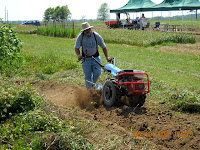Not much happened on the Farm this week. David transplanted some Cherokee Purple Tomatoes in Section 4 of the test plot that we purchased in early May. David usually works on various farm projects during the week and both David and Donald try to work on those projects better handled by two people on Friday evenings, Saturday, and Sundays; however, this week has been somewhat disjointed so no other work was done. We did get a little rain so have not had to water the garden this week.
There is a lot of work yet to do. We need to complete the henhouse, dig the trench to install the chicken wire, and secure it with rebar for the chickens. We also need to get the other vegetables planted, which we hope to complete next weekend. We will be gathering rock from the various rock piles around the front of the property to place along the fence line for the Turkey run, which (1) gets rid of the rock piles around our trees and (2) will secure the Turkey run from domestic animals. Another project is to mow the hay in the pasture, rake it into windrows (manually), and start a real mulching/composting operation so that we have mulch and compost for our winter cover crops.
During the Beginning Farmers and Ranchers class in May, Donald had the opportunity to watch a demonstration of preparing a raised planting bed. The demonstration showed how to (1) mow down the cover crop, (2) plow/till the ground to form raised beds, (3) transplant vegetables, and (4) use the cover crop that was mowed as green mulch. While it took less than 30 minutes to prepare a bed about 10 feet long, some very expensive equipment was used.
 |
| BCS Tractor |
The BCS Tractor is a walk-behind tractor that has the same capabilities of a regular tractor, including a PTO (Power Take Off). Here, the instructor is using the BCS Tractor to till the strip while forming a raised bed. Instead of standard tines, he is using a rotary plow, which will actually till the soil and move it to one side to form the bed.
You can see the cover crop that was just mowed on the left side of the picture, the windrow was formed by manually raking the cover crop to the side. The cover crop was mowed with a sickle bar mower attachment mounted to the BCS Tractor, and was manually raked over the transplants after they were planted.
The BCS Tractor costs approximately $4,300 (model BCS 853) with a standard rototiller attachment. The 45" Sickle bar attachment is another $979.00. While it would make life much easier to have this piece of equipment, it would be hard to justify the cost.
And yes, you can also get a plow attachment for the BCS Tractor.
 |
| BCS Tractor Plowing |
In last week's blog you saw some of the hand tools we use, and in previous blogs you saw some of the power equipment we have available. Our purpose here at Baker Heritage Farms is not only to grow all-natural crops in a natural environment, but to do so using as few power tools as possible, as power tools add substantially to the cost of operating a back-yard, or small acreage, farm.
We found that, with a little extra labor, we can prepare a raised bed with a regular tiller and hand tools just as well as we could with the BCS Tractor, though it takes longer and the work is much harder.
Donald also had the opportunity to see a number of different types of seed planters during the class.
 |
| Hand Seeders |
 |
| Restored Automatic Hand Seeder |
The had seeders were nothing fancy and can most likely be made from scrapes from around the house or farm. The walk-behind seeders (yes, they do have modern ones) would save back pain, but can run well over $100.00. The problem with any of the mechanical seeders is that there appears to be a high margin for error when planting, that could result in either wasted seed or wasted ground.
When planting larger areas, it is just as easy to drop the seed into a furrow and cover it with a rake (be careful of the wind, which can cause the seed to land outside the furrow).
Once again, here at Baker Heritage Farms, we will be planting by hand without the benefit of mechanical help.
If you are farming a very small area for profit, you will need to save as much money as possible if you want to make a profit. If you are farming a very small area to provide healthy food products for your own table, you will get more satisfaction from doing as much as possible by hand (the old-fashioned way).
If you are looking to farm on a larger scale, then the mechanical and power equipment may be an option, but remember, mechanical and power equipment needs to be maintained and sometimes the maintenance and repairs on this equipment can take valuable time away from your gardening chores.
Until next week;
Blessings to all from Baker Heritage Farms
No comments:
Post a Comment